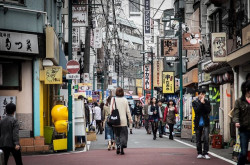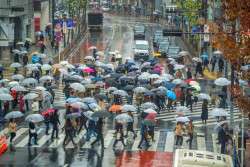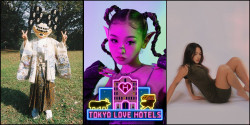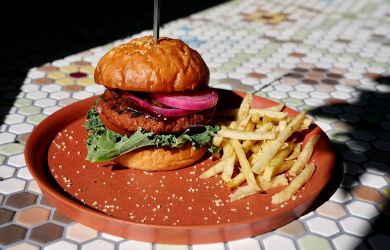
March 5, 2009
Pretty in Pink
As Tokyoites get pumped up for hanami season, Metropolis offers tips, trivia, history—and wigs
By Metropolis

Katsukawa Shuncho, Cherry Blossom Viewing at Asuka-yama, 18th century Courtesy of the Ukiyo-e Ota Memorial Museum of Art
The First Hanami
Hanami, the most Japanese of traditions, actually has some roots in China. The first literary references to sakura appear in 8th-century works of Japanese history called Kojiki (“The Records of Ancient Matters”) and Nihon Shoki (“The Chronicles of Japan”). The practice really gained prominence in the Nara (710-784) and Heian periods (794-1185)—the golden age of the Japanese court—when the Imperial house sponsored acts of flower viewing as aesthetic appreciation under the cultural influence of the Tang dynasty. The Chinese link initially produced an admiration for the imported plum blossom (ume). But the fact that Japan’s indigenous cherry tree blooms in the more pleasant springtime weather ensured its greater suitability and heralded lavish affairs, with banquets, archery, poetry contests and music festivals under the trees. This was strictly posh partying however, limited to the aristocracy in and around Kyoto.—Matthew Knott
Writes of spring
The Tale of Genji featured lengthy descriptions of the Heian lifestyle and definitively married the term hanami to the cherry tree. At a party organized by the caddish hero, the “branches caught in mists from either side were like a tapestry” and “poem followed poem. The young women seemed to forget that the day must end and they must go home.” Far from being just a technique to nampa the ladies, the ability to evoke the beauty of sakura was also one way to advance careers. Kokinshu, the 10th-century Imperial anthology of waka poetry, was stuffed with blossom odes:
If ours were a world
Where blossoming cherry trees
Were not to be found,
What tranquillity would bless
The human heart in springtime!
—MK
Pretty as a picture
The pastime of hanami has endured for hundreds of years, but as one look at Edo-era ukiyo-e will tell you, the same can not be said for fashion. From trends in clothing to ideals of feminine beauty, what is cutting-edge today soon becomes—well, ridiculous. The Ota Museum’s upcoming exhibition, Japanese Beauty, traces the ever-changing concept of attractiveness across 200 years of Japanese art. Compare the cute and childlike girls of Harunobu Suzuki with Kiyonaga Torii’s slender, willowy beauties, and on to the glamorous, decadent women favored by late-Edo period artist Eisen Keisai. The second part of the exhibit follows the evolution of female beauty all the way to the shin hanga of the Taisho period.
April 1-26, Ukiyo-e Ota Museum of Art. See exhibition listings (Harajuku/Aoyama) for details.
Flower Pedals
The Half-Fast Cycling club, organized by Metropolis’ own Movie Man, Don Morton, embarks on at least three hanami rides during this time of fleeting beauty. Some are as short as 30km, others up to 70km. Email halffastcy
cling@hotmail.com for details.
Bloomsday
Regular springtime viewers of NHK news will be familiar with the sight of an incredibly patient weatherman standing under a tree pointing at leaves for two weeks, as the Meteorological Agency and the media obsessively follow the “cherry blossom front.” Each city has a sample set of trees used to officially declare the first blossom (kaika). Tokyo’s is located at Yasukuni Shrine, whose sakura average March 28, but is often much earlier. Predicting the arrival of the blossoms is a thankless task, as a premature announcement can lead to scores of calls from disappointed hanami seekers seemingly reluctant to use their own eyes and common sense. Yet such information is vital for some people devoted to hanami to the extent of chasing the front from Okinawa all the way to Hokkaido. Progress can be followed at the dedicated sakura map website. www.mapple.net/sp_sakura—MK
Spring break
If you’ve always wanted to experience Kyoto’s renowned sakura but haven’t been able to get the timing right, check out the next best thing. Cherry Blossoms of Kyoto: A Seasonal Portfolio (Kodansha International, 2009) is a handsome new paperback that takes readers through the city’s five traditional areas, with lush photographs and recommended itineraries for flower-viewing. Among the featured locations are the 10th-century Kitano Tenmangu Shrine, the little-known Jobon Rendai-ji temple, and the cherry-lined banks of the Takasegawa River. As landcape designer Sano Toemon XVI says in the foreword, “[T]he skill and sensibilities of the photographers unite to proclaim that here is where the celebration of spring in Kyoto begins.”
Available at bookstores throughout Tokyo for ¥1,890.
Seeing pink
Japan actually boasts over 300 different varieties of cherry trees. In Nature in Tokyo, A Guide to Plants and Animals in and around Tokyo, Kevin Short describes how ornamental varieties rapidly increased in the Edo Period (1603-1868). At the same time, greater numbers were planted in public areas such as Ueno Park, while later Meiji-era urban planning led to more roadside blossoms.
The most common variety in Tokyo is somei yoshino, a fast-growing species that yields its plentiful petals to the soft breeze to create the familiar blizzard of blossoms (known as sakura fubuki). Other popular types are the yamazakura, found in mountainous areas in southern Honshu, with almost pure white oblong leaves, and the shidarezakura, featuring down-swept branches and blossoms of a single, pinkish-white nature often planted in temple gardens. Shinjuku Gyoen acts as a showcase of horticultural history, with over 75 varieties. See http://tinyurl.com/gyoen.—MK









